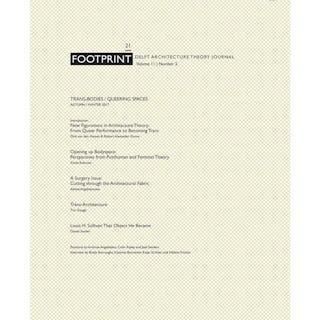Footprint | Vol. 11 | Issue 02
DELFT ARCHITECTURE THEORY JOURNAL

TRANS-BODIES / QUEERING SPACES
This issue of Footprint looks into the latest developments in queer theory and the related, newly emerging field of trans studies, and how they might inform and even reconceptualise architecture. Even though the introduction of queer theory into architecture dates back to the 1990s, there is still fairly little literature available specific to architecture. Most contemporary research into queer and trans theory happens in the fields of cultural studies, literature and the arts and social geography, whereas a cross-disciplinary connection between architecture, urban design and queer theory seems only logical from the point of view that architecture and urban design are instrumental in the formation of social and political identities. Additionally, queer and trans theory offers the possibility of opening up the disciplinary straightjacket of architecture: it engenders a radical reconceptualisation of the architectural discipline and its institutions in that queer and trans theory unsettles any conception of architecture as an embodiment of essentialist categories, be it identities, forms and types, just as it disturbs the mythologies of authorship and autonomy. Concerned with radical inclusiveness, this issue proposes to use ‘queering’ and ‘transing’ as lenses to more generally critique ‘exclusive’ conceptions of architecture, as well as mutually exclusive container concepts of spaces and bodies. What could architecture do, if we would leave behind essentialist approaches? Would it be possible to ‘undo’ the body of architecture and architecture theory and to allow for new figurations of knowledge, to ‘queer’ our understanding of architecture as a field engaged in consistent transformation, the material interface of processes of becoming?
Colin Ripley's contribution "Strategies for Living in Houses" offers the following provocation - "The problem of queer housing can never go away because it is a central component of queerness. The problem of queer housing remains persistent and recalcitrant because the house – the single-family house and by extension apartments, condominiums and the like – is a central structure of heterosexual hegemony, the primary architectural expression of hetero-normativity. All housing, at least in the developed world, is designed and constructed from within that hegemonic tradition, using models that assume heteronormativity in its users: even if the client for a new house is, for example, a gay couple, all decisions made in the design are made from within a straight tradition, all construction is produced by a construction industry formed around non-queer hegemonic industrial and business practices, all materials sourced and processed from within an exploitative colonising regime of resource extraction. And what would be different anyway? Wouldn’t our hypothetical gay couple want the same things as everyone else: a master bedroom with ensuite bath, a guest bedroom or maybe a room for the kid, a yard where they can sit out and a patio for barbecuing,
a living room with a huge TV"…